A Gentle Introduction to Machine Learning - Predicting Real Estate Prices
If you’re lucky, at some point in your life, you get the chance to purchase a property or even a house. However, here begins a painful journey of looking for your dream home and being shocked when taking a look at the price tag. When an acceptable and affordable home has been found despite the difficulties, there’s still one important question: Is the price fair? If you ask the owner, it sure is. Now imagine there’s a software that tells you if it really is. This answer is absolutely based on data and fairly objective. To do this, it’s best to train a machine learning model.
Not exactly. Machine learning refers to a method in computer science that takes a specific piece of software called a 'model', and a data set called 'training dataset' and computes a lot of values called 'weights' used in the model to fit the training dataset. After this step, we say that the model is 'trained' and given a dataset similar to the training dataset, it can make predictions for our previously specified values of interest called 'target values'. Though not entirely accurate, in short we can say that the process of machine learning is pattern recognition in given data. This process is similar to the way humans look at a bunch of numbers and try to figure out the defining rule or pattern.
Suppose you’d like to purchase a house in Ames, Iowa. It just so happens that there’s a great collection of housing data just for this place called the Ames Housing dataset. This dataset is a collection of almost 3,000 sold properties with up to 80 attributes recorded for each transaction. Thus, we barely need a way to train a machine learning model to ‘guess’ the prices of the sold properties correctly so it can give a reasonable price estimate for our dream home.
Nowadays, the most popular language used to work with machine learning models is Python. Python has a lot of great modules and libraries specifically developed for this and is really easy to use. The Python module scikit-learn is a comprehensive collection of different machine learning models. We’ll train a few models and combine their estimates to get an even better result.
- First, we’re gonna visualize the training data to get a feel for this particular data set. A few corrections to unrealistic or non-representative data points called outliers usually also need to be done at this point.
- Next, we’ll train the models using the training set. This step can be repeated when specific parameters of the models called ‘hyperparameters’ were tweaked to yield better results.
However, for the sake of simplicity and as a combination of models is used to make predictions, this step will be skipped in this tutorial. In the last step, we’re gonna let the models make predictions on housing data they’ve never seen before but for which the ‘right solution’ (real sale price) is available to us. This way, we can evaluate the performance of our trained models.

The following section is a converted Jupyter notebook. For the original file, see my GitHub repository at https://github.com/sdomoszlai13/predicting-housing-prices.
Predicting House Prices with ML in a Jupyter Notebook
In this notebook, we are going to build a machine learning model that predicts prices of houses based on historical data.
Data:
The dataset we’re gonna work with is the Ames Housing dataset. It contains 80 attributes for 2,930 properties in Ames, Iowa and was completed in 2011. The attributes include number and type of rooms, location specific data and special features of the property (pool, fireplace etc.). Each row in the dataset represents a single house.
Goal:
Predict sale price of a house as accurately as possible, based on data about the house features and location.
Models:
Based on finished notebooks available on Kaggle, it seems that a stacked model can produce even more accurate results than tuning hyperparameters of a single model. In this notebook we’ll follow this approach. A combination of the following models will be used for superior performance: LightGBM Regressor, XGBoost Regressor, Epsilon-Support Vector Regressor, Ridge, Random Forest Regressor, Gradient Boosting Regressor.
Evaluation:
The evaluation metric is the Root-Mean-Squared-Error. The smaller the error, the better.
Result:
The result is a well-trained, blended machine learning model that predicts prices in the test set with a Root-Mean-Squared-Error of about 7.5%.
First, we import libaries.
import pandas as pd
import matplotlib.pyplot as plt
import numpy as np
import seaborn as sns
from scipy import stats, special
from sklearn.model_selection import KFold, cross_val_score
from sklearn.metrics import mean_squared_error
import lightgbm as lgb
from lightgbm import LGBMRegressor
from xgboost import XGBRegressor
from sklearn.svm import SVR
from sklearn.ensemble import RandomForestRegressor, GradientBoostingRegressor
from sklearn.linear_model import Ridge, RidgeCV
from sklearn.preprocessing import RobustScaler
from mlxtend.regressor import StackingCVRegressor
from sklearn.pipeline import make_pipeline
import warnings
# Show plots in notebook
%matplotlib inline
# Ignore warnings
warnings.filterwarnings(action = "ignore")
pd.options.display.max_seq_items = 8000
pd.options.display.max_rows = 8000
DATA
Next, we import the training and test data.
# Import train and test data
house_train = pd.read_csv("./data/train.csv")
house_test = pd.read_csv("./data/test.csv")
# Take a look at the first 5 rows of the training data
house_train.head()
| Id | MSSubClass | MSZoning | LotFrontage | LotArea | Street | Alley | LotShape | LandContour | Utilities | ... | PoolArea | PoolQC | Fence | MiscFeature | MiscVal | MoSold | YrSold | SaleType | SaleCondition | SalePrice | |
|---|---|---|---|---|---|---|---|---|---|---|---|---|---|---|---|---|---|---|---|---|---|
| 0 | 1 | 60 | RL | 65.0 | 8450 | Pave | NaN | Reg | Lvl | AllPub | ... | 0 | NaN | NaN | NaN | 0 | 2 | 2008 | WD | Normal | 208500 |
| 1 | 2 | 20 | RL | 80.0 | 9600 | Pave | NaN | Reg | Lvl | AllPub | ... | 0 | NaN | NaN | NaN | 0 | 5 | 2007 | WD | Normal | 181500 |
| 2 | 3 | 60 | RL | 68.0 | 11250 | Pave | NaN | IR1 | Lvl | AllPub | ... | 0 | NaN | NaN | NaN | 0 | 9 | 2008 | WD | Normal | 223500 |
| 3 | 4 | 70 | RL | 60.0 | 9550 | Pave | NaN | IR1 | Lvl | AllPub | ... | 0 | NaN | NaN | NaN | 0 | 2 | 2006 | WD | Abnorml | 140000 |
| 4 | 5 | 60 | RL | 84.0 | 14260 | Pave | NaN | IR1 | Lvl | AllPub | ... | 0 | NaN | NaN | NaN | 0 | 12 | 2008 | WD | Normal | 250000 |
5 rows × 81 columns
house_test.head()
| Id | MSSubClass | MSZoning | LotFrontage | LotArea | Street | Alley | LotShape | LandContour | Utilities | ... | ScreenPorch | PoolArea | PoolQC | Fence | MiscFeature | MiscVal | MoSold | YrSold | SaleType | SaleCondition | |
|---|---|---|---|---|---|---|---|---|---|---|---|---|---|---|---|---|---|---|---|---|---|
| 0 | 1461 | 20 | RH | 80.0 | 11622 | Pave | NaN | Reg | Lvl | AllPub | ... | 120 | 0 | NaN | MnPrv | NaN | 0 | 6 | 2010 | WD | Normal |
| 1 | 1462 | 20 | RL | 81.0 | 14267 | Pave | NaN | IR1 | Lvl | AllPub | ... | 0 | 0 | NaN | NaN | Gar2 | 12500 | 6 | 2010 | WD | Normal |
| 2 | 1463 | 60 | RL | 74.0 | 13830 | Pave | NaN | IR1 | Lvl | AllPub | ... | 0 | 0 | NaN | MnPrv | NaN | 0 | 3 | 2010 | WD | Normal |
| 3 | 1464 | 60 | RL | 78.0 | 9978 | Pave | NaN | IR1 | Lvl | AllPub | ... | 0 | 0 | NaN | NaN | NaN | 0 | 6 | 2010 | WD | Normal |
| 4 | 1465 | 120 | RL | 43.0 | 5005 | Pave | NaN | IR1 | HLS | AllPub | ... | 144 | 0 | NaN | NaN | NaN | 0 | 1 | 2010 | WD | Normal |
5 rows × 80 columns
# Take a look at additional info regarding the training data
house_train.info()
<class 'pandas.core.frame.DataFrame'>
RangeIndex: 1460 entries, 0 to 1459
Data columns (total 81 columns):
# Column Non-Null Count Dtype
--- ------ -------------- -----
0 Id 1460 non-null int64
1 MSSubClass 1460 non-null int64
2 MSZoning 1460 non-null object
3 LotFrontage 1201 non-null float64
4 LotArea 1460 non-null int64
5 Street 1460 non-null object
6 Alley 91 non-null object
7 LotShape 1460 non-null object
8 LandContour 1460 non-null object
9 Utilities 1460 non-null object
10 LotConfig 1460 non-null object
11 LandSlope 1460 non-null object
12 Neighborhood 1460 non-null object
13 Condition1 1460 non-null object
14 Condition2 1460 non-null object
15 BldgType 1460 non-null object
16 HouseStyle 1460 non-null object
17 OverallQual 1460 non-null int64
18 OverallCond 1460 non-null int64
19 YearBuilt 1460 non-null int64
20 YearRemodAdd 1460 non-null int64
21 RoofStyle 1460 non-null object
22 RoofMatl 1460 non-null object
23 Exterior1st 1460 non-null object
24 Exterior2nd 1460 non-null object
25 MasVnrType 1452 non-null object
26 MasVnrArea 1452 non-null float64
27 ExterQual 1460 non-null object
28 ExterCond 1460 non-null object
29 Foundation 1460 non-null object
30 BsmtQual 1423 non-null object
31 BsmtCond 1423 non-null object
32 BsmtExposure 1422 non-null object
33 BsmtFinType1 1423 non-null object
34 BsmtFinSF1 1460 non-null int64
35 BsmtFinType2 1422 non-null object
36 BsmtFinSF2 1460 non-null int64
37 BsmtUnfSF 1460 non-null int64
38 TotalBsmtSF 1460 non-null int64
39 Heating 1460 non-null object
40 HeatingQC 1460 non-null object
41 CentralAir 1460 non-null object
42 Electrical 1459 non-null object
43 1stFlrSF 1460 non-null int64
44 2ndFlrSF 1460 non-null int64
45 LowQualFinSF 1460 non-null int64
46 GrLivArea 1460 non-null int64
47 BsmtFullBath 1460 non-null int64
48 BsmtHalfBath 1460 non-null int64
49 FullBath 1460 non-null int64
50 HalfBath 1460 non-null int64
51 BedroomAbvGr 1460 non-null int64
52 KitchenAbvGr 1460 non-null int64
53 KitchenQual 1460 non-null object
54 TotRmsAbvGrd 1460 non-null int64
55 Functional 1460 non-null object
56 Fireplaces 1460 non-null int64
57 FireplaceQu 770 non-null object
58 GarageType 1379 non-null object
59 GarageYrBlt 1379 non-null float64
60 GarageFinish 1379 non-null object
61 GarageCars 1460 non-null int64
62 GarageArea 1460 non-null int64
63 GarageQual 1379 non-null object
64 GarageCond 1379 non-null object
65 PavedDrive 1460 non-null object
66 WoodDeckSF 1460 non-null int64
67 OpenPorchSF 1460 non-null int64
68 EnclosedPorch 1460 non-null int64
69 3SsnPorch 1460 non-null int64
70 ScreenPorch 1460 non-null int64
71 PoolArea 1460 non-null int64
72 PoolQC 7 non-null object
73 Fence 281 non-null object
74 MiscFeature 54 non-null object
75 MiscVal 1460 non-null int64
76 MoSold 1460 non-null int64
77 YrSold 1460 non-null int64
78 SaleType 1460 non-null object
79 SaleCondition 1460 non-null object
80 SalePrice 1460 non-null int64
dtypes: float64(3), int64(35), object(43)
memory usage: 924.0+ KB
# Plot a histogram of the target column (SalePrice)
sns.set_style("white")
sns.set_color_codes(palette = "deep")
fig, ax = plt.subplots(figsize = [8, 7])
sns.histplot(house_train["SalePrice"], kde = "True", color = "b") # kde: Kernel Density Estimate
# not using displot because that's a figure-level function
ax.xaxis.grid(False)
ax.set(ylabel = "Frequency")
ax.set(xlabel = "SalePrice")
ax.set(title = "SalePrice distribution")
sns.despine(trim = True, left = True)
plt.show()
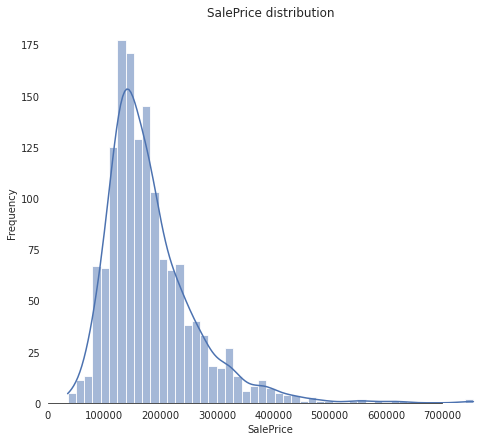
# Look at how spread out and symmetric the graph is
print("Kurtosis: %f" % house_train["SalePrice"].kurt())
print("Skewness: %f" % house_train["SalePrice"].skew())
Kurtosis: 6.536282
Skewness: 1.882876
The kurtosis and skewness values tell us that the distribution has a pretty sharp peak and that it is “leaning” to the left, i. e., there is a high number of cheaper houses and there are a few extremely expensive ones.
Now, let’s look at the features. Start by getting to know numeric features.
# Filter numeric features
numeric_datatypes = ["int16", "int32", "int64", "float16", "float32", "float64"]
numeric_cols = []
for i in house_train.columns:
if house_train[i].dtype in numeric_datatypes:
if i in ["TotalSF", "Total_Bathrooms","Total_porch_sf","haspool","hasgarage","hasbsmt","hasfireplace"]:
pass
else:
numeric_cols.append(i)
Now, let’s look at the correlation between features of the houses and the sale price. To do this, we plot the distribution of the numeric data. Data points far away from the rest are called outliers and make predictions harder.
# Plot numeric data
fig, ax = plt.subplots(ncols = 2, nrows = 1, figsize = (12, 120))
plt.subplots_adjust(right = 2)
plt.subplots_adjust(top = 2)
sns.color_palette("husl", 8)
for i, feature in enumerate(list(house_train[numeric_cols]), 1):
if(feature == "MiscVal"):
break
plt.subplot(len(list(numeric_cols)), 3, i)
sns.scatterplot(x = feature, y = "SalePrice", hue = "SalePrice", palette = "Blues", data = house_train)
plt.xlabel("{}".format(feature), size = 15,labelpad = 12.5)
plt.ylabel("SalePrice", size = 15, labelpad = 12.5)
for j in range(2):
plt.tick_params(axis = "x", labelsize = 12)
plt.tick_params(axis = "y", labelsize = 12)
plt.legend(loc = "best", prop = {"size": 10})
plt.show()

Let’s analyze this topic also with the help of a correlation matrix.
corr_matrix = house_train.corr()
plt.subplots(figsize = (15, 12))
sns.heatmap(corr_matrix, vmax = 0.9, cmap = "Blues", square = True);
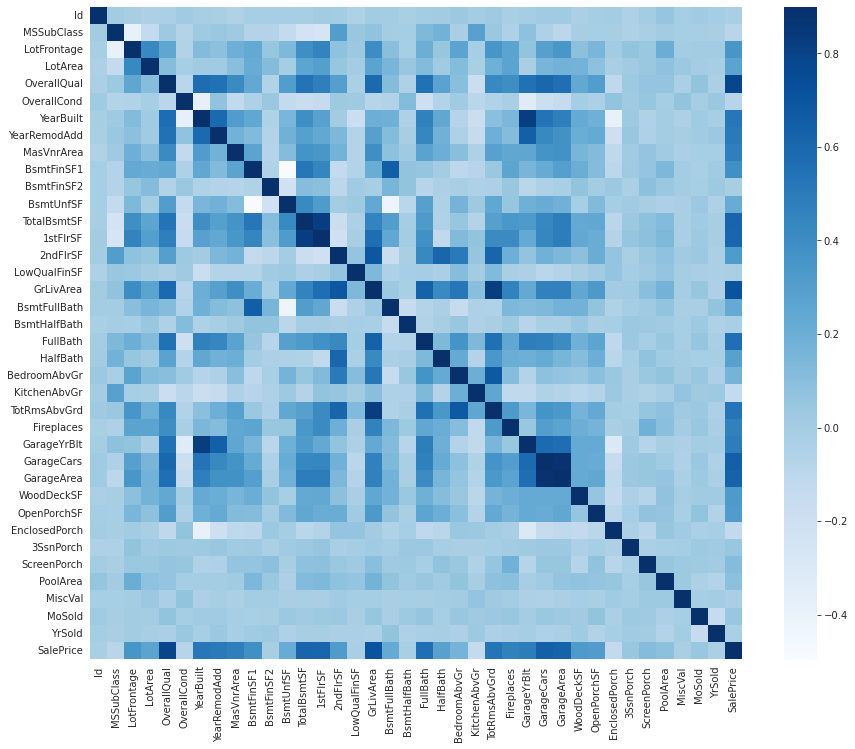
We can see that the feature that correlates the strongest with the sale price is overall quality, which shouldn’t come as a surprise. The second most influental on the sale price is the gross living area, which is also something we could suspect.
Let’s analyze strongly correlating features more closely.
data = pd.concat([house_train["SalePrice"], house_train["OverallQual"]], axis = 1)
f, ax = plt.subplots(figsize = (8, 6))
fig = sns.boxplot(x = house_train["OverallQual"], y = house_train["SalePrice"], data = data)
fig.axis(ymin = 0, ymax = 800000);
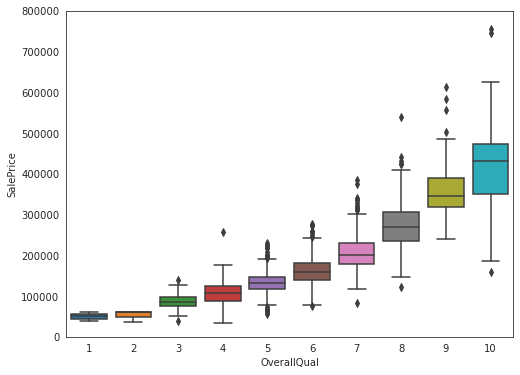
data = pd.concat([house_train["SalePrice"], house_train["YearBuilt"]], axis = 1)
f, ax = plt.subplots(figsize = (16, 8))
fig = sns.boxplot(x = house_train["YearBuilt"], y = house_train["SalePrice"], data = data)
fig.axis(ymin = 0, ymax = 800000)
plt.xticks(rotation = 45);
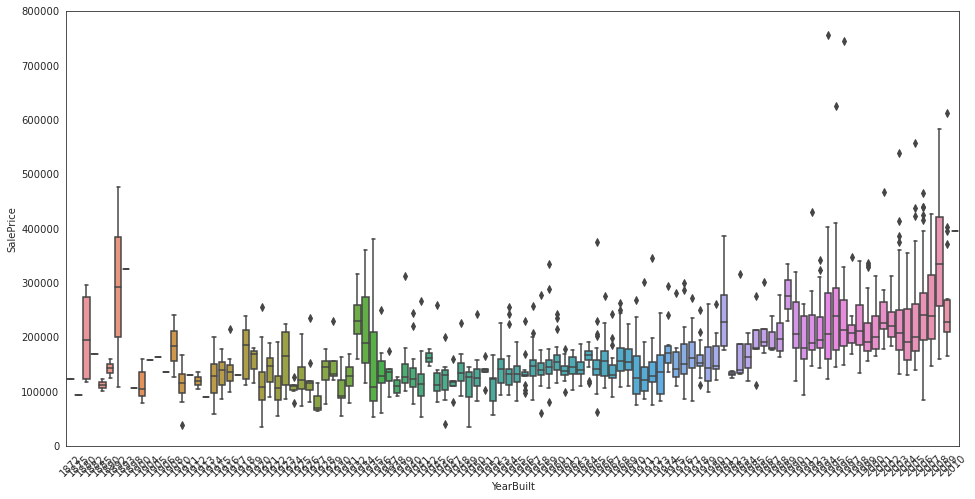
data = pd.concat([house_train["SalePrice"], house_train["TotalBsmtSF"]], axis = 1)
data.plot.scatter(x = "TotalBsmtSF", y = "SalePrice", alpha = 0.3, ylim = (0, 800000));
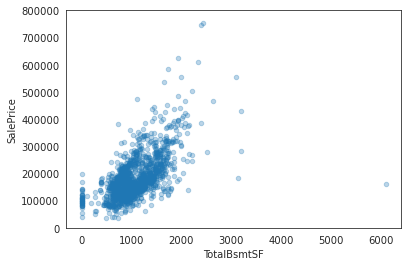
data = pd.concat([house_train["SalePrice"], house_train["LotArea"]], axis = 1)
data.plot.scatter(x = "LotArea", y = "SalePrice", alpha = 0.3, ylim = (0, 800000));
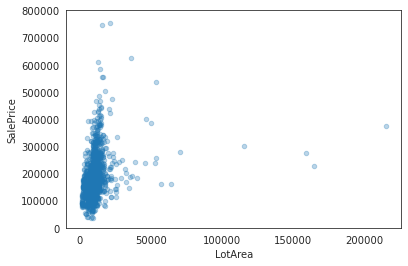
data = pd.concat([house_train["SalePrice"], house_train["GrLivArea"]], axis = 1)
data.plot.scatter(x = "GrLivArea", y = "SalePrice", alpha = 0.3, ylim = (0, 800000));
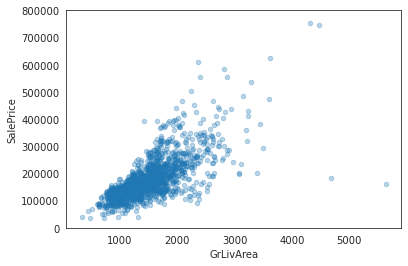
Now, let’s prepare our data for model training. First, we need to remove the IDs as we won’t be using them to train our models.
house_train.reset_index(drop = True, inplace = True)
house_test.reset_index(drop = True, inplace = True)
house_train.shape, house_test.shape
((1460, 81), (1459, 80))
FEATURE ENGINEERING
Now it’s time to do some feature engineering. Let’s look again at the plot of the target column (sale price).
sns.set_style("white")
sns.set_color_codes(palette = "deep")
fig, ax = plt.subplots(figsize = (8, 7))
sns.histplot(house_train["SalePrice"], color = "b", kde = True);
ax.xaxis.grid(False)
ax.set(ylabel = "Frequency")
ax.set(xlabel = "SalePrice")
ax.set(title = "SalePrice distribution")
sns.despine(trim = True, left = True)
plt.show()
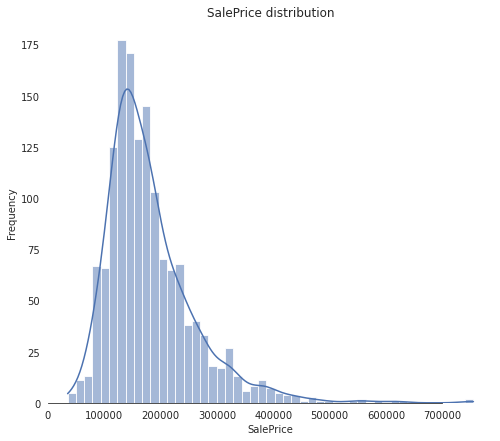
As we can see from the image above, the sale price graph is positively skewed. This can be a problem as most machine learning models don’t do well on normal distributions with significant skew. To change this, we can take the logarithm of the sale price.
house_train["SalePrice"] = np.log1p(house_train["SalePrice"])
# Define function to plot a normal distribution
def normal(mean, std, color = "black"):
x = np.linspace(mean - 4 * std, mean + 4 * std, 200)
p = stats.norm.pdf(x, mean, std)
z = plt.plot(x, p, color, linewidth = 2)
sns.set_style("white")
sns.set_color_codes(palette = "deep")
fig, ax = plt.subplots(figsize = (8, 7))
sns.histplot(house_train["SalePrice"], stat = "density", color = "b", kde = True)
ax.xaxis.grid(False)
ax.set(xlabel = "Sale Price", ylabel = "Frequency", title = "Sale Price Distribution")
sns.despine(trim = True, left = True)
# Plot normal distribution with no skew or kurtosis
normal(house_train["SalePrice"].mean(), house_train["SalePrice"].std())
plt.show();
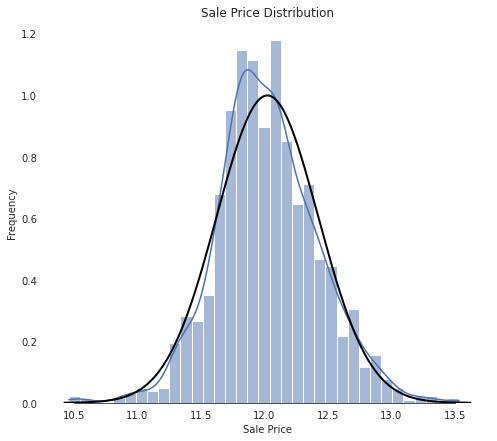
In the next step, we’re gonna remove outliers. These are single data points far away from the rest of the data and are therefore not representative for the dataset as a whole. There are multiple methods to determine which data point exactly is an outlier. Some examples are:
- IQR Testing
- Grubbs Test
- Isolation Forest
- Z-Score Method
In this notebook, a variation of the Z-score method will be used. This means that we look at how far away a data point is from the mean in terms of standard deviation. If the distance is more than a pre-defined value, we discard the data point. In particular, if a house is in really poor condition (overall quality) and really expensive (sale price) at the same time, there must be something special about the house that isn’t true for most of the properties. Similarly, if a house is really big (gross living area) but also really cheap, it’s probably not representative for out dataset as a whole. For this reason, we will discard these data points. We’re gonna define these cut-off values through an educated guess (based on the above graphs) and see if we get a good result.
# Drop outliers
house_train.drop(house_train[(house_train["OverallQual"] < 5) & (house_train["SalePrice"] > 200000)].index, inplace = True)
house_train.drop(house_train[(house_train["GrLivArea"] > 4500) & (house_train["SalePrice"] < 300000)].index, inplace = True)
house_train.reset_index(drop = True, inplace = True)
# Create labels and features containers
house_train_labels = house_train["SalePrice"].reset_index(drop = True)
house_train_features = house_train.drop(["SalePrice"], axis = 1)
house_test_features = house_test
# Combine train and test features in order to apply the feature transformation pipeline to the entire dataset
all_features = pd.concat([house_train_features, house_test_features]).reset_index(drop = True)
all_features.shape
(2917, 80)
In large datasets, there are usually gaps in the data where values couldn’t be determined or just haven’t been supplied. The performance of machine learning algorithms suffers heavily from such missing data. For this reason, we’re gonna make an estimate or determine missing values in the dataset and fill in the gaps. This can happen through one of the following methods:
- calculate missing values based on a known formula
- assume missing values to be equal to the mean/median of the values in the column of the missing value
- assume missing values to be equal to 0 (“default: missing” option)
We’re going to a mixture of these in the following steps.
# Determine fraction of missing values
def missingCalc(df):
data = pd.DataFrame(df)
df_cols = list(pd.DataFrame(data))
missing_fractions = {}
for i in range(len(df_cols)):
missing_fractions.update({df_cols[i]: round(data[df_cols[i]].isnull().mean()*100,2)})
return missing_fractions
missing = missingCalc(all_features)
df_miss = sorted(missing.items(), key = lambda x: x[1], reverse = True)
print("Percentage of missing data")
df_miss[:10]
Percentage of missing data
[('PoolQC', 99.69),
('MiscFeature', 96.4),
('Alley', 93.21),
('Fence', 80.43),
('FireplaceQu', 48.68),
('LotFrontage', 16.66),
('GarageYrBlt', 5.45),
('GarageFinish', 5.45),
('GarageQual', 5.45),
('GarageCond', 5.45)]
There’s quite a lot data missing. Let’s visualize that.
# Visualize missing values
sns.set_style("white")
sns.set_color_codes(palette = "deep")
fig, ax = plt.subplots(figsize = (8, 7))
missing = round(house_train.isnull().mean() * 100, 2)
missing = missing[missing > 0]
missing.sort_values(inplace = True)
missing.plot.bar(color = "b")
ax.xaxis.grid(False)
ax.set(ylabel = "Percentage of missing values")
ax.set(xlabel = "Features")
ax.set(title = "Percentage of missing data by feature")
sns.despine(trim = True, left = True)
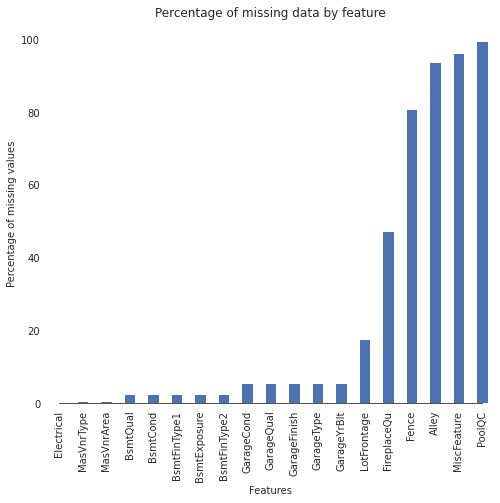
Now we’re gonna convert non-numeical features stored as numbers to strings to reflect the nature of the data.
# Convert non-numeric columns that store values as numbers to strings
all_features["MSSubClass"] = all_features["MSSubClass"].apply(str)
all_features["YrSold"] = all_features["YrSold"].astype(str)
all_features["MoSold"] = all_features["MoSold"].astype(str)
We now can fill the gaps in the data with suitable values. Let’s define a function that can achieve this.
def fillMissingData(features):
# The data description states that "NA" refers to typical ("Typ") values
features["Functional"] = features["Functional"].fillna("Typ")
# Replace the missing values in each of the columns below with their mode
features["Electrical"] = features["Electrical"].fillna("SBrkr")
features["KitchenQual"] = features["KitchenQual"].fillna("TA")
features["Exterior1st"] = features["Exterior1st"].fillna(features["Exterior1st"].mode()[0])
features["Exterior2nd"] = features["Exterior2nd"].fillna(features["Exterior2nd"].mode()[0])
features["SaleType"] = features["SaleType"].fillna(features["SaleType"].mode()[0])
features["MSZoning"] = features.groupby("MSSubClass")["MSZoning"].transform(lambda x: x.fillna(x.mode()[0]))
# The data description states that "NA" refers to "No Pool"
features["PoolQC"] = features["PoolQC"].fillna("None")
# Replacing the missing values with 0, since no garage = no cars in garage
for col in ("GarageYrBlt", "GarageArea", "GarageCars"):
features[col] = features[col].fillna(0)
# Replacing the missing values with "None"
for col in ["GarageType", "GarageFinish", "GarageQual", "GarageCond"]:
features[col] = features[col].fillna("None")
# "NaN" values for these categorical basement features mean there's no basement
for col in ("BsmtQual", "BsmtCond", "BsmtExposure", "BsmtFinType1", "BsmtFinType2"):
features[col] = features[col].fillna("None")
# Group features by neighborhood, and fill missing value by the median LotFrontage of the neighborhood
features["LotFrontage"] = features.groupby("Neighborhood")["LotFrontage"].transform(lambda x: x.fillna(x.median()))
# For the missing values in the rest of the categorical features, there's not enough information to fill them properly, so they're filled with "None"
objects = []
for i in features.columns:
if features[i].dtype == object:
objects.append(i)
features.update(features[objects].fillna("None"))
# The same is true for the numerical features, so the gaps are filled with zeros
numeric_dtypes = ["int16", "int32", "int64", "float16", "float32", "float64"]
numeric = []
for i in features.columns:
if features[i].dtype in numeric_dtypes:
numeric.append(i)
features.update(features[numeric].fillna(0))
return features
all_features = fillMissingData(all_features)
# Check if we handled all the missing values
missing = missingCalc(all_features)
missing_sorted = sorted(missing.items(), key = lambda x: x[1], reverse = True)
print("Percentage of missing data")
missing_sorted[:10]
Percentage of missing data
[('Id', 0.0),
('MSSubClass', 0.0),
('MSZoning', 0.0),
('LotFrontage', 0.0),
('LotArea', 0.0),
('Street', 0.0),
('Alley', 0.0),
('LotShape', 0.0),
('LandContour', 0.0),
('Utilities', 0.0)]
We can see that there are no more missing values, so we can move on to the next step: fixing skewed features.
# Fetch all numeric features
numeric_dtypes = ["int16", "int32", "int64", "float16", "float32", "float64"]
numeric = []
for i in all_features.columns:
if all_features[i].dtype in numeric_dtypes:
numeric.append(i)
# Create box plots for all numeric features
sns.set_style("white")
f, ax = plt.subplots(figsize = (8, 7))
ax.set_xscale("log")
ax = sns.boxplot(data = all_features[numeric] , orient = "h", palette = "Set1")
ax.xaxis.grid(False)
ax.set(ylabel = "Feature names")
ax.set(xlabel = "Numeric values")
ax.set(title = "Numeric distribution of features")
sns.despine(trim = True, left = True)
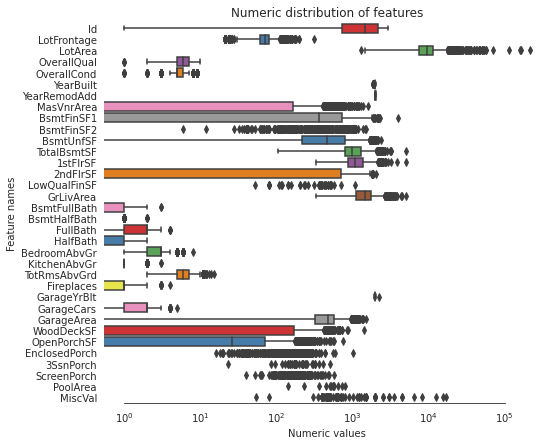
# Find skewed numerical features
skew_features = all_features[numeric].apply(lambda x: stats.skew(x)).sort_values(ascending=False)
high_skew = skew_features[skew_features > 0.5]
skew_index = high_skew.index
print("There are {} numerical features with skew > 0.5: ".format(high_skew.shape[0]))
skewness = pd.DataFrame({"Skew": high_skew})
skew_features.head(10)
There are 25 numerical features with skew > 0.5:
MiscVal 21.939672
PoolArea 17.688664
LotArea 13.109495
LowQualFinSF 12.084539
3SsnPorch 11.372080
KitchenAbvGr 4.300550
BsmtFinSF2 4.144503
EnclosedPorch 4.002344
ScreenPorch 3.945101
BsmtHalfBath 3.929996
dtype: float64
The skewed features should be nomalized for the machine learning models to perform well.
# Normalize skewed features
for i in skew_index:
all_features[i] = special.boxcox1p(all_features[i], stats.boxcox_normmax(all_features[i] + 1))
/usr/lib/python3/dist-packages/scipy/stats/_stats_py.py:4068: PearsonRConstantInputWarning: An input array is constant; the correlation coefficient is not defined.
warnings.warn(PearsonRConstantInputWarning())
/usr/lib/python3/dist-packages/scipy/stats/_stats_py.py:4098: PearsonRNearConstantInputWarning: An input array is nearly constant; the computed correlation coefficient may be inaccurate.
warnings.warn(PearsonRNearConstantInputWarning())
# Let's make sure we handled all the skewed values
sns.set_style("white")
f, ax = plt.subplots(figsize = (8, 7))
ax.set_xscale("log")
ax = sns.boxplot(data = all_features[skew_index] , orient = "h", palette = "Set1")
ax.xaxis.grid(False)
ax.set(ylabel = "Feature names")
ax.set(xlabel = "Numeric values")
ax.set(title = "Numeric Distribution of Features")
sns.despine(trim = True, left = True)
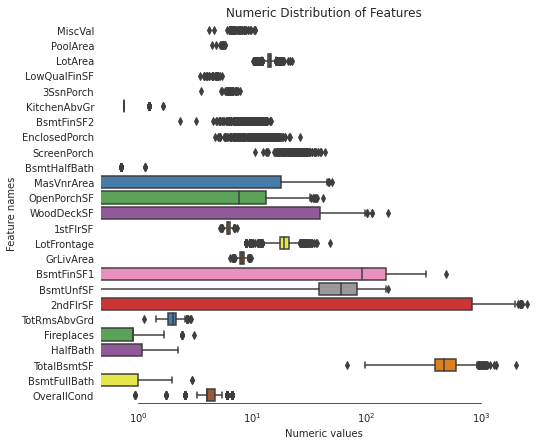
CREATING INTERESTING FEATURES
To help the machine learning models recognize complex pattens, we’re gonna create some features we think could be of significance for the price of the house (e. g., total area of rooms).
all_features["BsmtFinType1_Unf"] = (all_features["BsmtFinType1"] == "Unf") * 1
all_features["HasWoodDeck"] = (all_features["WoodDeckSF"] == 0) * 1
all_features["HasOpenPorch"] = (all_features["OpenPorchSF"] == 0) * 1
all_features["HasEnclosedPorch"] = (all_features["EnclosedPorch"] == 0) * 1
all_features["Has3SsnPorch"] = (all_features["3SsnPorch"] == 0) * 1
all_features["HasScreenPorch"] = (all_features["ScreenPorch"] == 0) * 1
all_features["YearsSinceRemodel"] = all_features["YrSold"].astype(int) - all_features["YearRemodAdd"].astype(int)
all_features["Total_Home_Quality"] = all_features["OverallQual"] + all_features["OverallCond"]
all_features = all_features.drop(["Utilities", "Street", "PoolQC",], axis = 1)
all_features["TotalSF"] = all_features["TotalBsmtSF"] + all_features["1stFlrSF"] + all_features["2ndFlrSF"]
all_features["YrBltAndRemod"] = all_features["YearBuilt"] + all_features["YearRemodAdd"]
all_features["Total_sqr_footage"] = (all_features["BsmtFinSF1"] + all_features["BsmtFinSF2"] +
all_features["1stFlrSF"] + all_features["2ndFlrSF"])
all_features["Total_Bathrooms"] = (all_features["FullBath"] + (0.5 * all_features["HalfBath"]) +
all_features["BsmtFullBath"] + (0.5 * all_features["BsmtHalfBath"]))
all_features["Total_porch_sf"] = (all_features["OpenPorchSF"] + all_features["3SsnPorch"] +
all_features["EnclosedPorch"] + all_features["ScreenPorch"] +
all_features["WoodDeckSF"])
all_features["TotalBsmtSF"] = all_features["TotalBsmtSF"].apply(lambda x: np.exp(6) if x <= 0.0 else x)
all_features["2ndFlrSF"] = all_features["2ndFlrSF"].apply(lambda x: np.exp(6.5) if x <= 0.0 else x)
all_features["GarageArea"] = all_features["GarageArea"].apply(lambda x: np.exp(6) if x <= 0.0 else x)
all_features["GarageCars"] = all_features["GarageCars"].apply(lambda x: 0 if x <= 0.0 else x)
all_features["LotFrontage"] = all_features["LotFrontage"].apply(lambda x: np.exp(4.2) if x <= 0.0 else x)
all_features["MasVnrArea"] = all_features["MasVnrArea"].apply(lambda x: np.exp(4) if x <= 0.0 else x)
all_features["BsmtFinSF1"] = all_features["BsmtFinSF1"].apply(lambda x: np.exp(6.5) if x <= 0.0 else x)
all_features["haspool"] = all_features["PoolArea"].apply(lambda x: 1 if x > 0 else 0)
all_features["has2ndfloor"] = all_features["2ndFlrSF"].apply(lambda x: 1 if x > 0 else 0)
all_features["hasgarage"] = all_features["GarageArea"].apply(lambda x: 1 if x > 0 else 0)
all_features["hasbsmt"] = all_features["TotalBsmtSF"].apply(lambda x: 1 if x > 0 else 0)
all_features["hasfireplace"] = all_features["Fireplaces"].apply(lambda x: 1 if x > 0 else 0)
Transform features
Now we’re gonna create some more features. These will be the squares of the logs of numerical features because they will be almost normally distributed after the transformation.
def createLog(res, ls):
m = res.shape[1]
for l in ls:
res = res.assign(newcol = pd.Series(np.log(1.01+res[l])).values)
res.columns.values[m] = l + "_log"
m += 1
return res
log_features = ["LotFrontage", "LotArea", "MasVnrArea", "BsmtFinSF1", "BsmtFinSF2", "BsmtUnfSF",
"TotalBsmtSF", "1stFlrSF", "2ndFlrSF", "LowQualFinSF", "GrLivArea",
"BsmtFullBath", "BsmtHalfBath", "FullBath", "HalfBath", "BedroomAbvGr", "KitchenAbvGr",
"TotRmsAbvGrd", "Fireplaces", "GarageCars", "GarageArea", "WoodDeckSF", "OpenPorchSF",
"EnclosedPorch", "3SsnPorch", "ScreenPorch", "PoolArea", "MiscVal", "YearRemodAdd", "TotalSF"]
all_features = createLog(all_features, log_features)
def createSquare(res, ls):
m = res.shape[1]
for l in ls:
res = res.assign(newcol = pd.Series(res[l] * res[l]).values)
res.columns.values[m] = l + "_sq"
m += 1
return res
squared_features = ["YearRemodAdd", "LotFrontage_log",
"TotalBsmtSF_log", "1stFlrSF_log", "2ndFlrSF_log", "GrLivArea_log",
"GarageCars_log", "GarageArea_log"]
all_features = createSquare(all_features, squared_features)
all_features = pd.get_dummies(all_features).reset_index(drop = True)
all_features.shape
(2917, 380)
all_features.head()
| Id | LotFrontage | LotArea | OverallQual | OverallCond | YearBuilt | YearRemodAdd | MasVnrArea | BsmtFinSF1 | BsmtFinSF2 | ... | SaleType_ConLw | SaleType_New | SaleType_Oth | SaleType_WD | SaleCondition_Abnorml | SaleCondition_AdjLand | SaleCondition_Alloca | SaleCondition_Family | SaleCondition_Normal | SaleCondition_Partial | |
|---|---|---|---|---|---|---|---|---|---|---|---|---|---|---|---|---|---|---|---|---|---|
| 0 | 1 | 18.144573 | 13.833054 | 7 | 3.991517 | 2003 | 2003 | 19.433175 | 144.117862 | 0.0 | ... | 0 | 0 | 0 | 1 | 0 | 0 | 0 | 0 | 1 | 0 |
| 1 | 2 | 20.673625 | 14.117918 | 6 | 6.000033 | 1976 | 1976 | 54.598150 | 181.719186 | 0.0 | ... | 0 | 0 | 0 | 1 | 0 | 0 | 0 | 0 | 1 | 0 |
| 2 | 3 | 18.668047 | 14.476512 | 7 | 3.991517 | 2001 | 2002 | 17.768840 | 110.441033 | 0.0 | ... | 0 | 0 | 0 | 1 | 0 | 0 | 0 | 0 | 1 | 0 |
| 3 | 4 | 17.249651 | 14.106196 | 7 | 3.991517 | 1915 | 1970 | 54.598150 | 61.795315 | 0.0 | ... | 0 | 0 | 0 | 1 | 1 | 0 | 0 | 0 | 0 | 0 |
| 4 | 5 | 21.314283 | 15.022008 | 8 | 3.991517 | 2000 | 2000 | 25.404164 | 136.624601 | 0.0 | ... | 0 | 0 | 0 | 1 | 0 | 0 | 0 | 0 | 1 | 0 |
5 rows × 380 columns
all_features.shape
(2917, 380)
# Remove any duplicated column names
all_features = all_features.loc[:,~all_features.columns.duplicated()]
all_features.shape
(2917, 379)
Now, we have to reassemble the training and test data sets.
X_train = all_features.iloc[:len(house_train_labels), :]
X_test = all_features.iloc[len(house_train_labels):, :]
X_train.shape, house_train_labels.shape, X_test.shape
((1458, 379), (1458,), (1459, 379))
Before we begin training, let’s visualize the data once more.
# Find numeric features
numeric = []
for i in X_train.columns:
if X_train[i].dtype in numeric_dtypes:
if i in ["TotalSF", "Total_Bathrooms", "Total_porch_sf", "haspool", "hasgarage", "hasbsmt", "hasfireplace"]:
pass
else:
numeric.append(i)
# Visualize some more outliers in the data
fig, axs = plt.subplots(ncols = 2, nrows = 1, figsize = (12, 150))
plt.subplots_adjust(right = 2)
plt.subplots_adjust(top = 2)
sns.color_palette("husl", 8)
for i, feature in enumerate(list(X_train[numeric]), 1):
if(feature == "MiscVal"):
break
plt.subplot(len(list(numeric)), 3, i)
sns.scatterplot(x = feature, y = "SalePrice", hue = "SalePrice", palette = "Blues", data = house_train)
plt.xlabel("{}".format(feature), size = 15,labelpad = 12.5)
plt.ylabel("SalePrice", size = 15, labelpad = 12.5)
for j in range(2):
plt.tick_params(axis = "x", labelsize = 12)
plt.tick_params(axis = "y", labelsize = 12)
plt.legend(loc = "best", prop = {"size": 10})
plt.show()
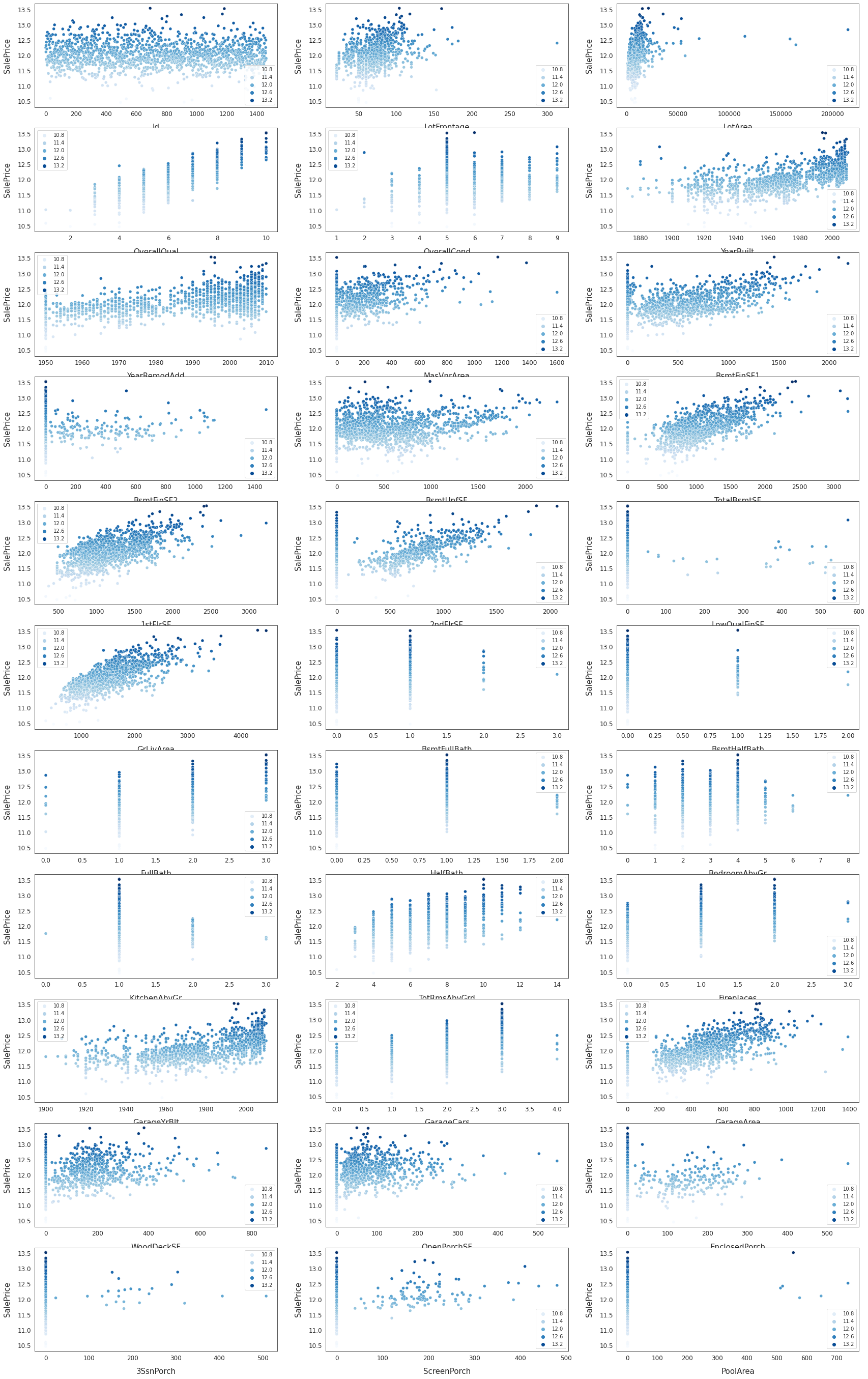
TRAINING MODELS
7 models are to be trained: lightgbm regressor, xgboost, ridge, gradient boosting, svr, and random forest. A meta StackingCVRegressor is also gonna be trained. Fo the end result, the predictions of the 7 models will be weighted according to their overall performance. 12-fold cross-validation will be used to determine the performance of the models. 10-fold cross-validation is used to get a more realistic idea of the performance of the models.
# Set up cross validation folds
kf = KFold(n_splits = 10, random_state = 42, shuffle = True)
# Define error metrics
def rmsle(y, y_pred):
return np.sqrt(mean_squared_error(y, y_pred))
def cv_rmse(model, X = X_train):
rmse = np.sqrt(-cross_val_score(model, X, house_train_labels, scoring = "neg_mean_squared_error", cv = kf))
return (rmse)
# Set up models
# Light Gradient Boosting Regressor
lightgbm = LGBMRegressor(objective = "regression",
num_leaves = 6,
learning_rate = 0.01,
n_estimators = 7000,
max_bin = 200,
bagging_fraction = 0.8,
bagging_freq = 4,
bagging_seed = 8,
feature_fraction = 0.2,
feature_fraction_seed = 8,
min_sum_hessian_in_leaf = 11,
verbose = -1,
random_state = 42)
# XGBoost Regressor
xgboost = XGBRegressor(learning_rate = 0.01,
n_estimators = 6000,
max_depth = 4,
min_child_weight = 0,
gamma = 0.6,
subsample = 0.7,
colsample_bytree = 0.7,
objective = "reg:squarederror",
nthread = -1,
scale_pos_weight = 1,
seed = 27,
reg_alpha = 0.00006,
random_state = 42)
# Ridge Regressor
ridge_alphas = [1e-15, 1e-10, 1e-8, 9e-4, 7e-4, 5e-4, 3e-4, 1e-4, 1e-3, 5e-2, 1e-2, 0.1, 0.3, 1, 3, 5, 10, 15, 18, 20, 30, 50, 75, 100]
ridge = make_pipeline(RobustScaler(), RidgeCV(alphas = ridge_alphas, cv = kf))
# Support Vector Regressor
svr = make_pipeline(RobustScaler(), SVR(C = 20, epsilon = 0.008, gamma = 0.0003))
# Gradient Boosting Regressor
gbr = GradientBoostingRegressor(n_estimators = 6000,
learning_rate = 0.01,
max_depth = 4,
max_features = "sqrt",
min_samples_leaf = 15,
min_samples_split = 10,
loss = "huber",
random_state = 42)
# Random Forest Regressor
rf = RandomForestRegressor(n_estimators = 1200,
max_depth = 15,
min_samples_split = 5,
min_samples_leaf = 5,
max_features = None,
oob_score = True,
random_state = 42)
# Stack up all the models above, optimized using xgboost
stack_gen = StackingCVRegressor(regressors = (xgboost, lightgbm, svr, ridge, gbr, rf),
meta_regressor = xgboost,
use_features_in_secondary = True)
In the next step, the models are gonna trained. Running the next couple of cells can take a few minutes.
stack_gen_model = stack_gen.fit(np.array(X_train), np.array(house_train_labels))
[19:05:07] WARNING: ../src/objective/regression_obj.cu:213: reg:linear is now deprecated in favor of reg:squarederror.
[19:06:39] WARNING: ../src/objective/regression_obj.cu:213: reg:linear is now deprecated in favor of reg:squarederror.
[19:07:30] WARNING: ../src/objective/regression_obj.cu:213: reg:linear is now deprecated in favor of reg:squarederror.
[19:08:10] WARNING: ../src/objective/regression_obj.cu:213: reg:linear is now deprecated in favor of reg:squarederror.
[19:08:53] WARNING: ../src/objective/regression_obj.cu:213: reg:linear is now deprecated in favor of reg:squarederror.
[LightGBM] [Warning] bagging_fraction is set=0.8, subsample=1.0 will be ignored. Current value: bagging_fraction=0.8
[LightGBM] [Warning] feature_fraction is set=0.2, colsample_bytree=1.0 will be ignored. Current value: feature_fraction=0.2
[LightGBM] [Warning] min_sum_hessian_in_leaf is set=11, min_child_weight=0.001 will be ignored. Current value: min_sum_hessian_in_leaf=11
[LightGBM] [Warning] bagging_freq is set=4, subsample_freq=0 will be ignored. Current value: bagging_freq=4
[LightGBM] [Warning] bagging_fraction is set=0.8, subsample=1.0 will be ignored. Current value: bagging_fraction=0.8
[LightGBM] [Warning] feature_fraction is set=0.2, colsample_bytree=1.0 will be ignored. Current value: feature_fraction=0.2
[LightGBM] [Warning] min_sum_hessian_in_leaf is set=11, min_child_weight=0.001 will be ignored. Current value: min_sum_hessian_in_leaf=11
[LightGBM] [Warning] bagging_freq is set=4, subsample_freq=0 will be ignored. Current value: bagging_freq=4
[LightGBM] [Warning] bagging_fraction is set=0.8, subsample=1.0 will be ignored. Current value: bagging_fraction=0.8
[LightGBM] [Warning] feature_fraction is set=0.2, colsample_bytree=1.0 will be ignored. Current value: feature_fraction=0.2
[LightGBM] [Warning] min_sum_hessian_in_leaf is set=11, min_child_weight=0.001 will be ignored. Current value: min_sum_hessian_in_leaf=11
[LightGBM] [Warning] bagging_freq is set=4, subsample_freq=0 will be ignored. Current value: bagging_freq=4
[LightGBM] [Warning] bagging_fraction is set=0.8, subsample=1.0 will be ignored. Current value: bagging_fraction=0.8
[LightGBM] [Warning] feature_fraction is set=0.2, colsample_bytree=1.0 will be ignored. Current value: feature_fraction=0.2
[LightGBM] [Warning] min_sum_hessian_in_leaf is set=11, min_child_weight=0.001 will be ignored. Current value: min_sum_hessian_in_leaf=11
[LightGBM] [Warning] bagging_freq is set=4, subsample_freq=0 will be ignored. Current value: bagging_freq=4
[LightGBM] [Warning] bagging_fraction is set=0.8, subsample=1.0 will be ignored. Current value: bagging_fraction=0.8
[LightGBM] [Warning] feature_fraction is set=0.2, colsample_bytree=1.0 will be ignored. Current value: feature_fraction=0.2
[LightGBM] [Warning] min_sum_hessian_in_leaf is set=11, min_child_weight=0.001 will be ignored. Current value: min_sum_hessian_in_leaf=11
[LightGBM] [Warning] bagging_freq is set=4, subsample_freq=0 will be ignored. Current value: bagging_freq=4
[19:16:32] WARNING: ../src/objective/regression_obj.cu:213: reg:linear is now deprecated in favor of reg:squarederror.
[19:17:21] WARNING: ../src/objective/regression_obj.cu:213: reg:linear is now deprecated in favor of reg:squarederror.
[LightGBM] [Warning] bagging_fraction is set=0.8, subsample=1.0 will be ignored. Current value: bagging_fraction=0.8
[LightGBM] [Warning] feature_fraction is set=0.2, colsample_bytree=1.0 will be ignored. Current value: feature_fraction=0.2
[LightGBM] [Warning] min_sum_hessian_in_leaf is set=11, min_child_weight=0.001 will be ignored. Current value: min_sum_hessian_in_leaf=11
[LightGBM] [Warning] bagging_freq is set=4, subsample_freq=0 will be ignored. Current value: bagging_freq=4
lgb_model_full_data = lightgbm.fit(X_train, house_train_labels)
xgb_model_full_data = xgboost.fit(X_train, house_train_labels)
[19:24:43] WARNING: ../src/objective/regression_obj.cu:213: reg:linear is now deprecated in favor of reg:squarederror.
svr_model_full_data = svr.fit(X_train, house_train_labels)
ridge_model_full_data = ridge.fit(X_train, house_train_labels)
rf_model_full_data = rf.fit(X_train, house_train_labels)
gbr_model_full_data = gbr.fit(X_train, house_train_labels)
scores = {}
score = cv_rmse(lightgbm)
scores["lgb"] = (score.mean(), score.std())
score = cv_rmse(xgboost)
scores["xgb"] = (score.mean(), score.std())
score = cv_rmse(svr)
scores["svr"] = (score.mean(), score.std())
score = cv_rmse(ridge)
scores["ridge"] = (score.mean(), score.std())
score = cv_rmse(rf)
scores["rf"] = (score.mean(), score.std())
score = cv_rmse(gbr)
scores["gbr"] = (score.mean(), score.std())
[LightGBM] [Warning] bagging_fraction is set=0.8, subsample=1.0 will be ignored. Current value: bagging_fraction=0.8
[LightGBM] [Warning] feature_fraction is set=0.2, colsample_bytree=1.0 will be ignored. Current value: feature_fraction=0.2
[LightGBM] [Warning] min_sum_hessian_in_leaf is set=11, min_child_weight=0.001 will be ignored. Current value: min_sum_hessian_in_leaf=11
[LightGBM] [Warning] bagging_freq is set=4, subsample_freq=0 will be ignored. Current value: bagging_freq=4
[LightGBM] [Warning] bagging_fraction is set=0.8, subsample=1.0 will be ignored. Current value: bagging_fraction=0.8
[LightGBM] [Warning] feature_fraction is set=0.2, colsample_bytree=1.0 will be ignored. Current value: feature_fraction=0.2
[LightGBM] [Warning] min_sum_hessian_in_leaf is set=11, min_child_weight=0.001 will be ignored. Current value: min_sum_hessian_in_leaf=11
[LightGBM] [Warning] bagging_freq is set=4, subsample_freq=0 will be ignored. Current value: bagging_freq=4
[LightGBM] [Warning] bagging_fraction is set=0.8, subsample=1.0 will be ignored. Current value: bagging_fraction=0.8
[LightGBM] [Warning] feature_fraction is set=0.2, colsample_bytree=1.0 will be ignored. Current value: feature_fraction=0.2
[LightGBM] [Warning] min_sum_hessian_in_leaf is set=11, min_child_weight=0.001 will be ignored. Current value: min_sum_hessian_in_leaf=11
[LightGBM] [Warning] bagging_freq is set=4, subsample_freq=0 will be ignored. Current value: bagging_freq=4
[LightGBM] [Warning] bagging_fraction is set=0.8, subsample=1.0 will be ignored. Current value: bagging_fraction=0.8
[LightGBM] [Warning] feature_fraction is set=0.2, colsample_bytree=1.0 will be ignored. Current value: feature_fraction=0.2
[LightGBM] [Warning] min_sum_hessian_in_leaf is set=11, min_child_weight=0.001 will be ignored. Current value: min_sum_hessian_in_leaf=11
[LightGBM] [Warning] bagging_freq is set=4, subsample_freq=0 will be ignored. Current value: bagging_freq=4
[LightGBM] [Warning] bagging_fraction is set=0.8, subsample=1.0 will be ignored. Current value: bagging_fraction=0.8
[LightGBM] [Warning] feature_fraction is set=0.2, colsample_bytree=1.0 will be ignored. Current value: feature_fraction=0.2
[LightGBM] [Warning] min_sum_hessian_in_leaf is set=11, min_child_weight=0.001 will be ignored. Current value: min_sum_hessian_in_leaf=11
[LightGBM] [Warning] bagging_freq is set=4, subsample_freq=0 will be ignored. Current value: bagging_freq=4
[LightGBM] [Warning] bagging_fraction is set=0.8, subsample=1.0 will be ignored. Current value: bagging_fraction=0.8
[LightGBM] [Warning] feature_fraction is set=0.2, colsample_bytree=1.0 will be ignored. Current value: feature_fraction=0.2
[LightGBM] [Warning] min_sum_hessian_in_leaf is set=11, min_child_weight=0.001 will be ignored. Current value: min_sum_hessian_in_leaf=11
[LightGBM] [Warning] bagging_freq is set=4, subsample_freq=0 will be ignored. Current value: bagging_freq=4
[LightGBM] [Warning] bagging_fraction is set=0.8, subsample=1.0 will be ignored. Current value: bagging_fraction=0.8
[LightGBM] [Warning] feature_fraction is set=0.2, colsample_bytree=1.0 will be ignored. Current value: feature_fraction=0.2
[LightGBM] [Warning] min_sum_hessian_in_leaf is set=11, min_child_weight=0.001 will be ignored. Current value: min_sum_hessian_in_leaf=11
[LightGBM] [Warning] bagging_freq is set=4, subsample_freq=0 will be ignored. Current value: bagging_freq=4
[LightGBM] [Warning] bagging_fraction is set=0.8, subsample=1.0 will be ignored. Current value: bagging_fraction=0.8
[LightGBM] [Warning] feature_fraction is set=0.2, colsample_bytree=1.0 will be ignored. Current value: feature_fraction=0.2
[LightGBM] [Warning] min_sum_hessian_in_leaf is set=11, min_child_weight=0.001 will be ignored. Current value: min_sum_hessian_in_leaf=11
[LightGBM] [Warning] bagging_freq is set=4, subsample_freq=0 will be ignored. Current value: bagging_freq=4
[LightGBM] [Warning] bagging_fraction is set=0.8, subsample=1.0 will be ignored. Current value: bagging_fraction=0.8
[LightGBM] [Warning] feature_fraction is set=0.2, colsample_bytree=1.0 will be ignored. Current value: feature_fraction=0.2
[LightGBM] [Warning] min_sum_hessian_in_leaf is set=11, min_child_weight=0.001 will be ignored. Current value: min_sum_hessian_in_leaf=11
[LightGBM] [Warning] bagging_freq is set=4, subsample_freq=0 will be ignored. Current value: bagging_freq=4
[LightGBM] [Warning] bagging_fraction is set=0.8, subsample=1.0 will be ignored. Current value: bagging_fraction=0.8
[LightGBM] [Warning] feature_fraction is set=0.2, colsample_bytree=1.0 will be ignored. Current value: feature_fraction=0.2
[LightGBM] [Warning] min_sum_hessian_in_leaf is set=11, min_child_weight=0.001 will be ignored. Current value: min_sum_hessian_in_leaf=11
[LightGBM] [Warning] bagging_freq is set=4, subsample_freq=0 will be ignored. Current value: bagging_freq=4
[LightGBM] [Warning] bagging_fraction is set=0.8, subsample=1.0 will be ignored. Current value: bagging_fraction=0.8
[LightGBM] [Warning] feature_fraction is set=0.2, colsample_bytree=1.0 will be ignored. Current value: feature_fraction=0.2
[LightGBM] [Warning] min_sum_hessian_in_leaf is set=11, min_child_weight=0.001 will be ignored. Current value: min_sum_hessian_in_leaf=11
[LightGBM] [Warning] bagging_freq is set=4, subsample_freq=0 will be ignored. Current value: bagging_freq=4
[LightGBM] [Warning] bagging_fraction is set=0.8, subsample=1.0 will be ignored. Current value: bagging_fraction=0.8
[LightGBM] [Warning] feature_fraction is set=0.2, colsample_bytree=1.0 will be ignored. Current value: feature_fraction=0.2
[LightGBM] [Warning] min_sum_hessian_in_leaf is set=11, min_child_weight=0.001 will be ignored. Current value: min_sum_hessian_in_leaf=11
[LightGBM] [Warning] bagging_freq is set=4, subsample_freq=0 will be ignored. Current value: bagging_freq=4
[20:06:49] WARNING: ../src/objective/regression_obj.cu:213: reg:linear is now deprecated in favor of reg:squarederror.
[20:07:42] WARNING: ../src/objective/regression_obj.cu:213: reg:linear is now deprecated in favor of reg:squarederror.
[20:08:36] WARNING: ../src/objective/regression_obj.cu:213: reg:linear is now deprecated in favor of reg:squarederror.
[20:09:31] WARNING: ../src/objective/regression_obj.cu:213: reg:linear is now deprecated in favor of reg:squarederror.
[20:10:25] WARNING: ../src/objective/regression_obj.cu:213: reg:linear is now deprecated in favor of reg:squarederror.
[20:11:18] WARNING: ../src/objective/regression_obj.cu:213: reg:linear is now deprecated in favor of reg:squarederror.
[20:12:12] WARNING: ../src/objective/regression_obj.cu:213: reg:linear is now deprecated in favor of reg:squarederror.
[20:13:09] WARNING: ../src/objective/regression_obj.cu:213: reg:linear is now deprecated in favor of reg:squarederror.
[20:14:02] WARNING: ../src/objective/regression_obj.cu:213: reg:linear is now deprecated in favor of reg:squarederror.
[20:14:56] WARNING: ../src/objective/regression_obj.cu:213: reg:linear is now deprecated in favor of reg:squarederror.
[20:15:50] WARNING: ../src/objective/regression_obj.cu:213: reg:linear is now deprecated in favor of reg:squarederror.
[20:16:43] WARNING: ../src/objective/regression_obj.cu:213: reg:linear is now deprecated in favor of reg:squarederror.
# Blend models in order to reduce overfitting
def blended_predictions(X):
return ((0.1 * ridge_model_full_data.predict(X)) + \
(0.2 * svr_model_full_data.predict(X)) + \
(0.1 * gbr_model_full_data.predict(X)) + \
(0.1 * xgb_model_full_data.predict(X)) + \
(0.1 * lgb_model_full_data.predict(X)) + \
(0.05 * rf_model_full_data.predict(X)) + \
(0.35 * stack_gen_model.predict(np.array(X))))
# Get final precitions from the blended model
blended_score = rmsle(house_train_labels, blended_predictions(X_train))
scores["blended"] = (blended_score, 0)
print("RMSLE score on train data: ")
print(blended_score)
RMSLE score on train data:
0.07509618668897956
Now we’re gonna identify the model that delivers the best results.
RESULTS
# Plot the predictions for each model
sns.set_style("white")
fig = plt.figure(figsize = (24, 12))
ax = sns.pointplot(x = list(scores.keys()), y = [score for score, _ in scores.values()], markers = ["o"], linestyles = ["-"])
for i, score in enumerate(scores.values()):
ax.text(i, score[0] + 0.002, "{:.6f}".format(score[0]), horizontalalignment = "left", size = "large", color = "black", weight = "semibold")
plt.ylabel("RMSE", size = 20, labelpad = 12.5)
plt.xlabel("Model", size = 20, labelpad = 12.5)
plt.tick_params(axis = "x", labelsize = 13.5)
plt.tick_params(axis = "y", labelsize = 12.5)
plt.title("Scores of models", size = 20)
plt.show()
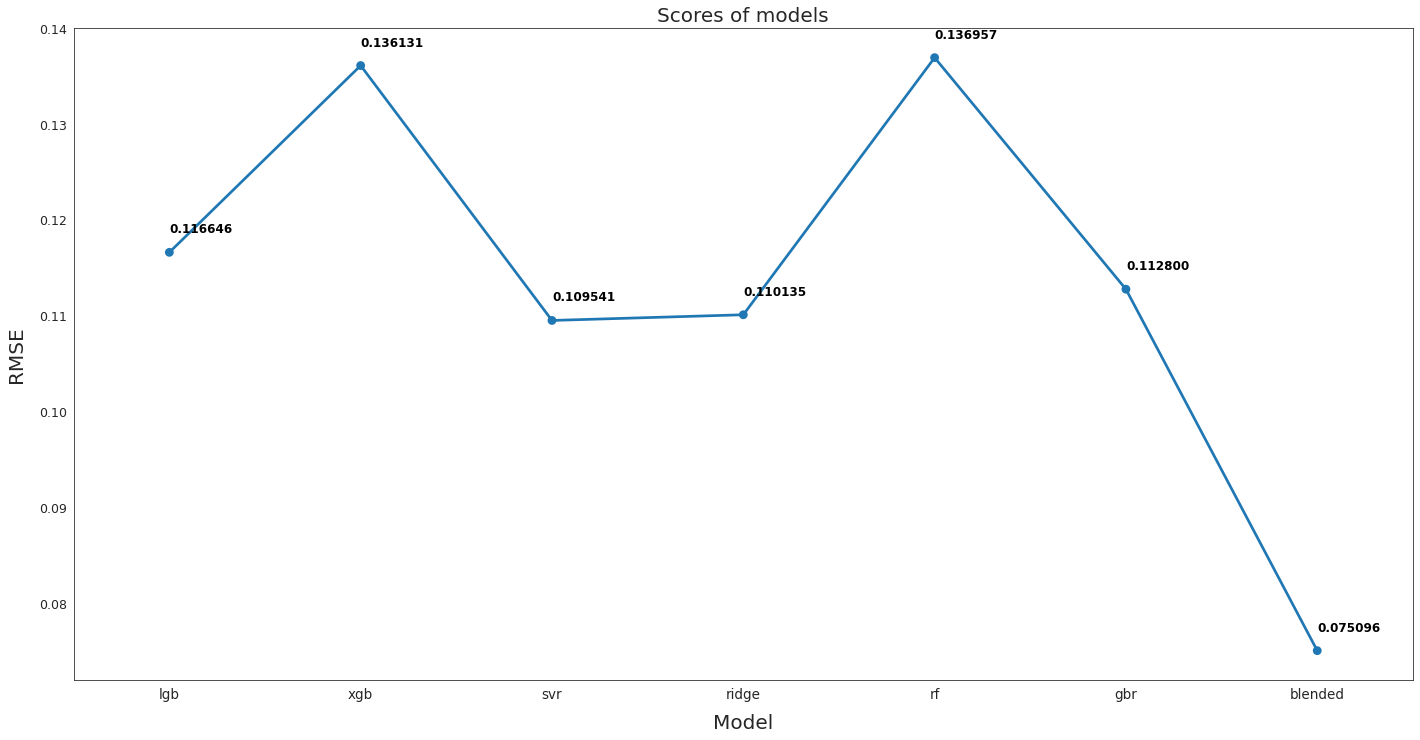
We can see that the blended model outperforms every other model. For this reason, this will be used to make predictions.
submission = pd.read_csv("./data/sample_submission.csv")
submission.shape
(1459, 2)
# Append predictions from blended model
submission.iloc[:,1] = np.floor(np.expm1(blended_predictions(X_test)))
# Fix outliers
q1 = submission["SalePrice"].quantile(0.0045)
q2 = submission["SalePrice"].quantile(0.99)
submission["SalePrice"] = submission["SalePrice"].apply(lambda x: x if x > q1 else x * 0.77)
submission["SalePrice"] = submission["SalePrice"].apply(lambda x: x if x < q2 else x * 1.1)
submission.to_csv("submission_regression.csv", index = False)
We’re finished! The predictions of the blended models have been saved to a file. Now let’s visualize some of the results.